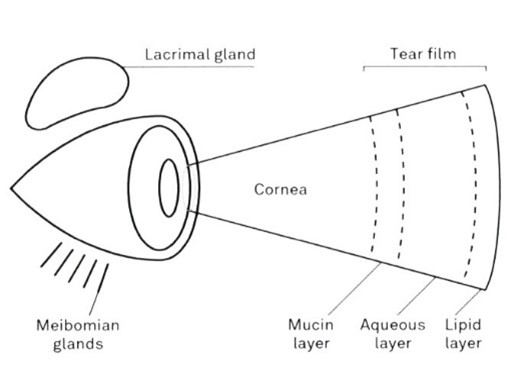Do you ever experience discomfort in your eyes, such as dryness, itchiness, a gritty feeling, or excessive tearing? These symptoms can be more than just a minor nuisance; they are signs that your eyes might not be functioning optimally. To support good vision and comfort, every part of the eye must work harmoniously. When something goes awry, it is essential to understand why and how we can address it.

When there is a disruption in the balance, or a decrease in quality or quantity of these layers, discomfort can occur, alongside noticeable symptoms such as red eyes or the presence of residue. Symptoms may include dryness, itchiness, a gritty sensation, or even excessive tearing. For instance, a deficient aqueous layer can lead to dryness, while compromised quality or quantity of the lipid layer can cause various sensations from stinging to grittiness, or even tearing of the eyes.
Dry eye syndrome can stem from a variety of risk factors. Aging is a natural cause as tear production diminishes over time, making older adults more susceptible. Allergies, hormonal shifts (notably during menopause), and lifestyle choices such as the overuse of eye makeup or long-term contact lens wear can disrupt tear film balance. Chronic conditions like blepharitis, inflammation of the eyelids, further complicate matters.

In our digital era, the blue light from screens can strain the eyes and decrease blink rate, further hampering the aqueous layer’s ability to keep moisture. Certain medications and environmental pollutants also contribute to altering tear composition and accelerating dry eye symptoms. Collectively, these elements can severely affect the ocular layers’ functionality, leading to the onset and aggravation of dry eye syndrome.
Fortunately, these uncomfortable conditions can be remedied, though recovery time may vary based on the duration and severity of the issue. Age can also influence the healing process, with older individuals potentially requiring longer time to recover. However, with consistent and proper care, it is possible to restore your eyes to their optimal state.
Embarking on the journey towards relief from eye discomfort can be daunting, but understanding the current state of your eyes is the crucial first step. For instance, if you experience stinging when applying eye drops, it might indicate that your eyes lack adequate moisture. Conversely, persistent redness without sensation may signal a more complex path to recovery. Selecting the appropriate eye drops for your condition can also be challenging. Various options are available, each serving different purposes. Regular drops such as Theratears, Evolve and Hylo-Forte aim to supplement poor tear quality and enhance the aqueous layer. Others like Theratears Gel and Vit-A-POS are designed for night use only, thereby maintaining eye moisture for longer periods. Using the wrong type of eye drops can exacerbate the issue rather than alleviate it. Therefore, it’s essential to identify your specific needs and choose the appropriate drops accordingly.

Optometrists typically employ several strategies to address these common eye concerns. Simple dry eye treatments may involve nutritional supplements, hot compress, lid wash and various eyedrops. They are effective, though more time consuming and take longer to have an effect. Alternatively, new technological advances like the Rexono Eye Treatment and Meibomask Eye Treatment stand out as effective solutions and shorten the treatment timeframe. These treatments target the underlying causes of discomfort, aiming to restore the natural balance of the eye’s protective layers.
For a deeper dive into these treatments and more detailed advice on managing dry eye symptoms, refer to our comprehensive guide: “Dry Eye Treatments.” Remember, proper eye care is crucial for maintaining not just your vision but also your overall quality of life. If you are experiencing any of the symptoms mentioned, consult an optometrist to explore your treatment options and/or call us to book an appointment.



